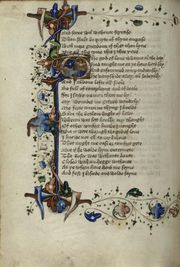
The Romaunt of the Rose
Encyclopedia

Middle English
Middle English is the stage in the history of the English language during the High and Late Middle Ages, or roughly during the four centuries between the late 11th and the late 15th century....
of the French allegory
Allegory
Allegory is a demonstrative form of representation explaining meaning other than the words that are spoken. Allegory communicates its message by means of symbolic figures, actions or symbolic representation...
, the Roman de la Rose
Roman de la Rose
The Roman de la rose, , is a medieval French poem styled as an allegorical dream vision. It is a notable instance of courtly literature. The work's stated purpose is to both entertain and to teach others about the Art of Love. At various times in the poem, the "Rose" of the title is seen as the...
. In Geoffrey Chaucer
Geoffrey Chaucer
Geoffrey Chaucer , known as the Father of English literature, is widely considered the greatest English poet of the Middle Ages and was the first poet to have been buried in Poet's Corner of Westminster Abbey...
's The Legend of Good Women
The Legend of Good Women
The Legend of Good Women is a poem in the form of a dream vision by Geoffrey Chaucer.The poem is the third longest of Chaucer’s works, after The Canterbury Tales and Troilus and Criseyde and is possibly the first significant work in English to use the iambic pentameter or decasyllabic couplets...
he confirms that he has translated at least part of the poem but the extant work is of dubious authenticity. Of the three existing fragments, the first uses Chaucer's language and style and is often accepted as his early work. The second seems to be written in northern English
Northern English
Northern English is a group of dialects of the English language. It includes the North East England dialects, which are similar in some respects to Scots....
and is rejected and the third part is closer to Chaucer's style but is also usually rejected.
The story begins with an allegorical dream, in which the narrator receives advice from the god of love on gaining his lady's favour, her love being symbolized by a rose, he is unable to get to the rose. The second fragment is a satire on the mores of the time, with respect to courting, religious order, and religious hypocrisy. In the second fragment, the narrator is able to kiss the rose, but then the allegorical character Jealousy builds a fortress encircling it so that the narrator does not have access to it. The third fragment of the translation takes up the poem 5,000 lines after the second fragment ends and at its beginning, the god of love is planning to attack the fortress of Jealousy with his barons. The rest of the fragment is a confession given by Fals-Semblant, or false-seeming, which is a treatise on the ways in which men are false to one another, especially the clergy to their parishioners. The third fragment ends with Fals-Semblant going to the fortress of Jealousy in the disguise of a religious pilgrim. He speaks with Wikked-Tunge that is holding one of the gates of the fortress and convinces him to repent his sins. The poem ends with Fals-Semblant absolving Wikked-Tunge of his sins.

